Marylou Simpson in 1950s Sun Valley
Photo by Penny Converse, photo colorized by Vickey Hanson - Mountain
Dreamworks.
Seventy Years of Sun, Snow and Stories
In honor of Sun Valley Resort’s 70th birthday, longtime resident and Idaho Mountain Express columnist Betty Bell records the reflections of some of its “children.”
When I sat down to begin this reminiscence, I looked for a handle, something to latch onto. Did I see Sun Valley as an “It?” Or a “Place?” Or as “Us?” What worked was “edifice,” and I’ll use it as a metaphor, even though I bet it loses integrity along the way. With edifice I got a clear picture of cornerstones, solid things to dust off, look at closely and read the names inscribed. The following characters were part of Sun Valley’s post-war history, occupying it roughly from the late ’40s to the early ’50s.
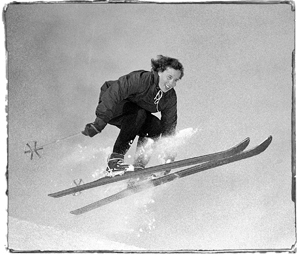
 Then and
now: Betty Bell, top, in her airborne racing days. Today, weaving
her magic words in her corner at the Idaho Mountain Express office in
Ketchum.
Then and
now: Betty Bell, top, in her airborne racing days. Today, weaving
her magic words in her corner at the Idaho Mountain Express office in
Ketchum.
General Manager W.P.
“Pappy” Rogers—a big man in every way, fiery but warm, demanding but
appreciative, wholly hands-on always, a greeter of nearly every incoming
bus and the rider of many a Shoshone-bound bus when it snaked its way
through the snowplowed canyon the highway often became. Abundant
snowfalls were common then.
Florence “Flo” Law, executive assistant. Most of us
suspected she was co-general manager, the lady who could smooth
everything out. For example, when Mr.Rogers’ softball team would get
whumped by Nedder’s team, my future husband’s team (Ned Bell was manager
of the employees’ cafeteria as well as the famous BoilerRoom), Mr.
Rogers would find him even though Ned had put some effort into not being
a highly visible target. Mr.Rogers would summarily fire him, tell him to
get to Personnel and pick up his train ticket back to York, Nebraska—and
“don’t miss that five o’clock bus to Shoshone!” But after an hour or two
of cooling-off time that likely included a chat with Mrs. Law, he’d seek
out Ned again, de-fire him, and tell him never mind about the bus.
Eddie Seagle, chief engineer. The man who made things work down here in
the valley and up on the mountain, and a man of many skills. In a time
of barely intermittent radio—forget TV—every blue-sky, aspen-gold fall,
he’d spool out a par five’s worth of wire in and around the Opera House
and splice them magically to pull in a silken voiced sportscaster who—to
a captivated audience ranging from bellhop to the big man
himself—artfully chanted the World Series play by play. I never saw
games with more clarity than those.
Dr. John Moritz, pioneer bone man. In a time of novel new ways to break
a leg, Dr. Moritz was a national innovator of procedures, plus being an
all-round physician —deliverer of my first two children in the wing on
the third floor of the Lodge that served as a hospital until a real one
was built. So beloved and respected was Dr. Moritz that we gave our new
hospital his name.
Bald Mountain has to be acknowledged here…dear Baldy, our Accessory
Dwelling Unit, our immovable, incomparable force.
I arrived in 1946, early enough to be linked to the
cornerstones—a flatlander come from Nebraska to learn to ski. There’s a
major chunk of time when I lost touch entirely with the world beyond, a
long run of focusing on getting to the mountain and riding free up the
three single-chair lifts—River Run, Exhibition and Ridge, and I was smug
if not snug in my hot-gear garb of three sweaters under a nylon shell. I
survived those rides by cocooning in the big, canvas-wool-lined cape
that lift attendants draped across every skier’s shoulders. When I skied
off on top I’d be warm again, ready for more play in the snow, ready to
bag as many as I could of the elusive nano-seconds of bliss and
perfection.
My first summer in Sun Valley, the one that hadn’t
been a part of my plan, I discovered that hiking wasn’t necessarily
horizontal, and that I could always do it in a National Geographic
setting…I discovered that golf was a new game to play but a hard thing
to learn on nine skinny fairways. Luckily there were plenty of hit-once-and-lost-forever Titleists sliced into the big-time rough to
offer free pickings and make the twenty-dollar season pass seem not too
steep. I stayed several summers to be positioned for winter before it
sank in that I was home.
Four fellow “first coursers” shared the tales that follow. Just between
us, I was taken aback to see how much they’ve aged. As young things,
we’d all linked up to the cornerstones about the same time and jointly
raised our kids who’ve had kids who’re raising kids now linked.
On this its …us …our—seventieth
birthday, I think it’s OK to say ‘Happy birthday, Mom.’
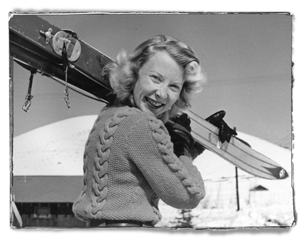

Then and now: Marylou Simpson, still smiling. Her husband, Jack, passed away in 2000.
It was a standard
address to the troops: “If you live here, you ski. Get on that mountain.
You have to be able to talk to guests about skiing.”
Marylou Simpson can’t pinpoint the first time she heard Mr. Rogers, the
general manager, preach this sermon, and since she was already a skier,
she embraced it as gospel.
Unlike many employees who hailed from Union Pacific headquarters in
Omaha, Marylou wasn’t a flatlander. The train she arrived on in Shoshone
hadn’t come from Omaha, and she didn’t have the railroad pass that was
part of the package for employees. She didn’t even have a job. When she
and two good friends stepped off into that hot first day of July in
1946, they had stubs for one-way tickets from Seattle—$20 each, coach.
“It was so flat…so dusty. I said, ‘What have we got ourselves into?’ But
then we got on the bus, and when we came down Timmerman Hill and saw the
mountains, I knew this was where I wanted to be.” The girls came to Sun
Valley at the urging of Jack Simpson, a young sailor on leave they’d met
in Seattle. Jack’s family had settled in Ketchum long before Mr.
Harriman discovered it. Owen, Jack’s father, owned what had first been
the Lewis/Lemon Grocery Store before becoming Simpson’s Grocery—a grand
old building that then morphed into the Golden Rule grocery store before
morphing through short-lived morphs I’ve forgotten into its present
reincarnation—Iconoclast Books. Before the war, Jack’s job had been to
drive the store’s truck over Galena Summit on the “wagon trail” and
deliver groceries in Stanley and Clayton.
Through Jack, that first summer, the girls found jobs as cocktail
waitresses in another of Owen’s enterprises, the Sawtooth Club. The
ladies were a big hit.
“There wasn’t a single gal in town,” Marylou said.
“The Navy, when it cleared out of Sun Valley, corralled them all.”
One of Marylou’s first Sun Valley jobs was at the
warming hut on top of Baldy, where she was cashier.
“I was the only one they’d let ski down with the money after work,” she
said. Most employees, though eager to follow Mr. Rogers’ commandment,
were still bunnies not to be counted on to get down the mountain with
the money sack intact.
Surprise: Marylou married Jack. Jack, who died in 2000, was instrumental
in launching the Sun Valley junior ski racing program that’s so solid
today, and through the years the Simpsons and their sons Mike and Pat
were entwined in Sun Valley’s ski history—Pat once won the National
Junior Championships.
When Jack was 16, he skied for Sonja Henie in the movie Sun Valley
Serenade. He skied all of the spectacular runs and cartwheeled through
all of the spectacular crashes—but at the end of every crash the camera
clicked off and didn’t click on again until it was back on a Hollywood
set and zeroed in on Miss Henie wiping ersatz snow from her face. She
never set foot in Sun Valley, poor thing—and Jack never shook his
nickname—“Sonja.”
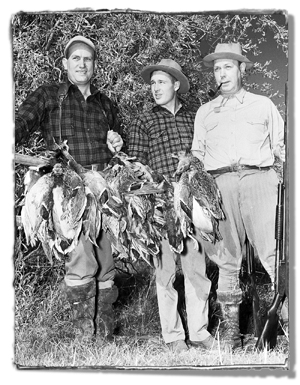
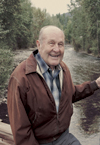
Then and now: Clayton Stewart, top center, hunted and fished with a myriad of Hollywood celebrities. Today, he is happy to fish in solitude along the Big Wood River.
It’s not likely you’d
be looking for Clayton Stewart to serve him a subpoena, but should you
be, you’d find him in Atkinsons’ Market in Ketchum, about nine on most
mornings. He’d be sitting at one of the small front tables, back-lit by
the sun with his hand around a cup of coffee. I didn’t have a subpoena;
he’d agreed to chat when I found him there. I said, “Hi Clayton,” and he
looked up and turned loose a gentle, slow-motion smile that spread clear
across his face, and I thought, “I remember that smile… .”
Clayton, an Idahoan, graduated from Shoshone High School in 1937 and
came directly to Sun Valley. He already had a job—as a fishing guide. He
was 16.
“Did you guide any celebrities?” I asked, not commenting about his
tender age. “Well…I took Gary Cooper fishing that summer…then in ’38
Hemingway was here, and I was his hunting guide. I did a lot of guiding
for Hemingway—he loved to kill things—I didn’t know there were people
who just like to kill things, but there are.”
Along with a few million others, I’ve fixed Hemingway close to the top
of my favorite authors, so when Clayton got even more specific I
interrupted. “Did you guide any other celebrities?”
“Oh yeah…what’s his name? You know…the guy with the big ears?” We sat
there stewing a bit as is the wont of those of us advanced in
far-ranging wisdom but challenged if we have to summon a specific name
from our vast collections. Surprisingly, a name did float out—“Clark
Gable?”
“Yep. That’s the one—I did a lot of fishing with Clark Gable.”
Clayton’s resume lists more than traipsing around country he loved and
getting paid for it. In the early ’40s he managed the State Liquor
Department in Sun Valley. “You mean the liquor store?”… “No, the State
Liquor Department,” he corrected. “Nobody drank anything but bourbon and
gin until guests started coming from back East—and they had a taste for
vodka and such. And wine—we didn’t know anything about wine, so Sun
Valley brought in a wine steward from Austria, Peter Riehl, I think it
was, and they built a wine vault in the Lodge basement—buried it
there—and then they made darn sure to hide the key so employees—most of
them teenagers, couldn’t get hold of it.”
In his stint as transportation manager, it wasn’t only getting guests in
and out of the valley he had to worry about, “There was all that
laundry.”
“Laundry?”
“Yeah—we had to ship out all the linen to UP headquarters in Pocatello
and get it done there…we’d get it all separated—sheets, pillowcases,
towels, all that stuff. Sometimes we’d fill up a couple cars.” Railroad
cars, he clarified—not Subarus.
Clayton, 89 now, still lives in Ketchum. Once in a while on a fine
summer day when it’s too busy here, he drives south to familiar and
cherished country around Hagerman. He doesn’t take a rod or gun with him
these days, nor do I imagine that he hankers to—he’s already lived the
best of it.
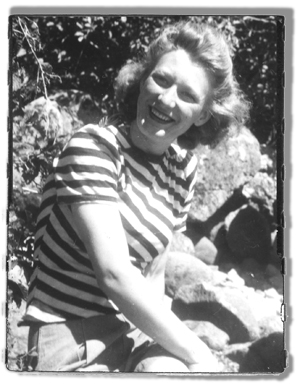
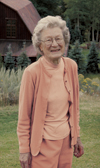 Then and
now: Petra Morrison relaxes atop a rock at Alturas Lake, and atop a
knoll overlooking her family’s
Then and
now: Petra Morrison relaxes atop a rock at Alturas Lake, and atop a
knoll overlooking her family’s
former property.
I’ve had a few
titles, but never “shrinking violet.” So when I called Petra and said
I’d like to hear a
couple of recollections from her early days in Sun Valley, I wasn’t put
off when she tried to steer me away: “You should talk to Earl McCoy—he
was one of our best early skiers—he won that Diamond Sun race straight
down Baldy.”
“Well, I’d really like to talk to you.”
“And Gladys McAtee—Val McAtee’s widow. Val, worked for Sun Valley for a
lot of years, and Gladys has wonderful stories—she’s in her nineties
now, but really sharp.”
“Uh huh—but I’d really like to talk to you.”
And Petra, the same courteous woman I remember from the late ’40s when
she worked in Sun Valley’s personnel department, gave in, and invited me
to her place—which is what I’d been angling for all along. I’d been to
Petra’s home once before, and I was curious to see if I’d still think
she sits atop the best piece of real estate in all of the Wood River
Valley. I do. She does.
Petra’s piece of real estate, where she lived with her husband, Frank,
until he died in 1994, is a roomy knoll on the north side of Weyakkin—earlier
that whole spread had been the Farnlun Place, owned by Petra’s
grandparents, who came to Ketchum in 1895. Just after you drive into
Weyakkin, a road on the left still signed Farnlun Place winds gradually
up and around to Petra’s knoll, and the panorama there swings from
beyond Hailey south to beyond Galena north.
At the dining room table with a window-wall featuring Baldy, I asked
Petra what it was like when construction started in Sun Valley. “Oh, it
was a big impact right away. I was going to a two-story brick school in
the middle of the block where Giacobbi Square is now. School was just
two rooms downstairs—upstairs was the gym. When construction started and
families began to move in, right away school became four rooms—and with
four teachers, too!”
“Was there friction with all the new kids?”
“No, no. Right away, we were close. They fit right in.
“There weren’t many buildings that first winter, and all the
construction workers lived in tents—they built them on platforms with
kind of walled sides and they had stoves in there—whole families lived
in tents. I was shocked—our house was small, but it had electricity—but
not indoor plumbing—and it sure seemed like a castle alongside those
tents.”
I asked Petra to tell me about one memorable “little thing.” “Well,” she
said, “the Personnel Department was right down the hall from Mr. Rogers’
office, and if it was getting close to Christmas and we still didn’t
have any snow or not enough, Mr. Rogers would come stomping down the
hall and just boom out, ‘Everybody get on over to church—pray for snow!
We need snow!’
“And I’d think, ‘Really… .’ But the
funny thing was, it always seemed to work.”